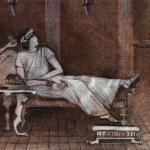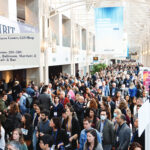
“What was is what will be; what has been done is what will be done.” —Ecclesiastes 1:9
Let me tell you about a series of seemingly unrelated events and how they do, in fact, connect with each other—and with something in the current literature.
Not long ago, my family and I concluded our ceremonial observances of the Jewish high holidays of Rosh Hashannah and Yom Kippur, and the (harvest) festival of Sukkot. These rituals are essential for my identity, for my connection to my religion, and for my spirituality. Between them, I managed to intersperse some relaxation, watching football. I was glad my alma mater, the University of Michigan, was having a better year than last, but disappointed that the University of Florida, where my family lived for 16 years, was struggling. I smile as I recall being in those college towns for the pageantry of fall football.
Recently, I attended the meetings of the Alliance for Academic Internal Medicine, dubbed Academic Internal Medicine Week. I participated in a workshop on managing transitions of leadership positions (which conclusively ended any lingering attachments I may have had to being a program director and department chair). A featured speaker at one of the lunches was Abraham Verghese, MD, professor of the theory and practice of medicine at the Stanford University School of Medicine in Stanford, Calif. His talk about the ritual of the physical examination was enjoyable and provocative.1-3 I have long admired the eloquence of his writing and the relevance of his messages. I had corresponded and spoken with him, unsuccessfully attempting to persuade him to visit us when I was at Saint Barnabas. It was a pleasure to meet him in person.
At home, at the end of the weekend of meetings, I turned on the television and stumbled upon “Fiddler on the Roof” being shown on one of the old movie channels. Who cannot recall Tevye and the singing of “Tradition”?
Finally, a few weeks later was the New York Marathon, an iconic annual event for any runner. I’ve completed it many times over five decades, from the 1970s through a few years ago, but was not entered this year.
And it was then that I came across several publications celebrating the benefits of new electronic technologies for rheumatology, reflecting the changing culture of medical practice.4-8 It was these seemingly unrelated events and experiences that led me to reflect on their fundamental similarities. I was reminded how ubiquitous are symbols, ritual, ceremony, and tradition in our lives—and not only our personal lives, but surely also professional ones. They are so constitutive to us, medically and individually, that our awareness of their power becomes blunted, almost subliminal. We particularly may overlook their meaning to others who are not of our worlds.
Ritual in Rheumatology
Rheumatology achieves a degree of uniqueness by its demands for unsurpassed clinical skills, empathy, intellectual curiosity, humanism, and old-fashioned caring. The “compleat” rheumatologist will appreciate the potency, influence, and symbolic importance of those rituals and ceremonies that reflect the art of our tradition.
My wife and I have each had experiences that reinforced these notions. My wife—quite discerning and rather knowledgeable about medicine (and other things)—has recognized omissions and inattention to details of the ritual evaluation when they are not included.
I recall a visit I made to an ophthalmologist for the first time for routine eye care. I was disappointed by the lack of personal warmth, somewhat cursory greeting, absence of white coat and tie,9-11 and inattention to old records. The ophthalmologist typed into the computer rather than engaging me in eye contact during our conversation, did not perform dilation, left the refraction to whomever optometrist I might see, and did not ask me if I had any questions. It was discomfiting.
Over time, we learn the subtleties that are essential for the good encounter. These were not they. I shared my reaction with one of my children (also knowledgeable about medicine and other things, though, disappointingly, not a physician), expecting, I guess, confirmation of my discerning insight. The response was something like, “Get over it, Dad. This is 2011. Southern California.” I thought about that, briefly, and fleetingly wondered about my investment in my child’s ivy-league education. I decided that I still believe that some traditions, symbols, and rituals have enduring value, not only for us but, importantly, for our patients (at least those who aren’t my children), and, I hope, for our acolytes.
Ritual in Action
Yesterday, I performed the “definitive” experiment. I determined to prove the notion that careful attention to the symbols, rituals, ceremonies, and traditions of the patient encounter would indeed win patients’ unqualified trust. I had been asked to see a patient in consultation for a colleague. My associate was frustrated by the patient’s unwillingness to accept his therapeutic recommendations.
Dr. Verghese had related that in his experience, when he was seeing patients with chronic fatigue syndrome, the ceremonies of listening attentively to the complete litany of complaints, carefully and visibly reviewing all records, and performing a lengthy, painstakingly thorough examination all invested him with an authority and confidence from patients that they were unwilling to accord physicians omitting any of these rituals. I had the luxury yesterday of being able to do this perhaps more conscientiously than usual because my “private practice” at the University of Southern California is limited, and often for consultations from other rheumatologists. Also, I decided to skip a potentially unproductive meeting and allocate all the time this patient might wish.
I reviewed everything. I tried to listen, even though I was familiar with the story. I was sure to have the patient disrobed and gowned, never examining through clothing, and not interposing gloves to the process. I looked at her fundi. I palpated her thyroid and listened over it for bruits. I was careful to touch and work all her joints. I watched her walk. I brought the radiographs up on the computer screen and explained them to her. I emphasized to her my respect for my colleague and his skill, clinical acumen, and concern. We spoke until she had no questions. She then assured me that I had won her trust; she would return to my colleague with renewed confidence (just like she had previously promised at each visit with him…). Q.E.D.
Dr. Panush is professor of medicine, Division of Rheumatology, at the Keck School of Medicine, University of Southern California, in Los Angeles.
References
- Verghese A, Brady E, Kapur C, Horwitz RI. The bedside evaluation: Ritual and reason. Ann Intern Med. 2011;155:550-553.
- Verghese A. Culture shock—patient as icon, icon as patient. New Engl J Med. 2008;359:2748-2751.
- Verghese A. Treat the patient not the CT scan. New York Times. February 27, 2011.
- Malaviya AN, Gogia SB. Development, implementation and benefits of a rheumatology-specific electronic medical record application with automated display of outcome measures. Int J Rheum Dis. 2010;13:347-360.
- Epis OM, Canesi B, Bruschi E, Sonnati K. Computer touch screen-based technology: A promising tool for the management of rheumatoid arthritis. Clin Exp Rheumatol. 2011;29:361-362.
- Kroese ME, Severens JL, Schulpen GJ, Bessems MC, Nijhuis FJ, Landwe RB. Specialized rheumatology nurse substitutes for rheumatologists in the diagnostic process of fibromyalgia: A cost-consequence analysis and randomized controlled trial. J Rheumatol. 2011;38:1413-1422.
- Hnamouchi I, Bahiri R, Srifi N, Aktaou S, Abouqal R, Hajjaj-Hassouni N. A comparison of ultrasound and clinical examination in the detection of flexor tenosynovitis in early arthritis. BMC Musculoskelet Disord. 2011;12:91.
- Kuriya B, Villeneuve E, Bombardier C. Diagnostic and prognostic value of history-taking and physical examination in undifferentiated peripheral inflammatory arthritis: A systematic review. J Rheumatol Suppl. 2011;87:10-14.
- Panush RS. “Chapter 8. Miscellaneous” in Yearbook of Rheumatology, Arthritis, and Musculoskeletal Diseases, RS Panush ed., Elsevier Mosby, Philadelphia, 2007; pp 324-327.
- Rehman SU, Nietert PJ, Cope DW, et al. What to wear today? Effect of doctor’s attire on the trust and confidence of patients. Amer J Med. 2005;118:1279-1286,
- Lill MM, Wilkinson TJ. Judging a book by its cover: Descriptive survey of patients’ preferences for doctors’ appearance and mode of dress. BMJ. 2005;331:1524-1527.


